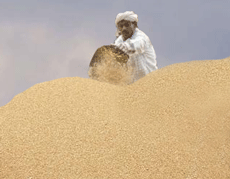India's foodgrain production hits a record 235.88 million tonnes
06 Apr 2011
India's foodgrain production reached a record 235.88 million tonnes during 2010-11, against 218.11 million tonnes in the previous year, as per the third advance estimates of crop production in the country. The previous record was 234.47 million tonnes, achieved in 2008-09.
 The year also saw record production of wheat in the country, at an estimated 84.27 million tonnes - a new record. Production of pulses, estimated at 17.29 million tonnes, also hit an all-time high.
The year also saw record production of wheat in the country, at an estimated 84.27 million tonnes - a new record. Production of pulses, estimated at 17.29 million tonnes, also hit an all-time high.
The record production has been achieved despite severe drought in some of the major rice producing areas of the country, with sizable increases in the production of wheat, pulses and coarse cereals, minister for agriculture and food processing industries Sharad Pawar said today.
Pawar said widespread drought, cyclonic storms and unseasonal rains and severe cold wave and frost had caused significant damage to crops in Bihar, Jharkhand, Orissa and West Bengal and several other parts of the country.
The year also saw a quantum jump in soyabean production with an increase of 2.62 million tonnes over its production during 2009-10.
Total oilseeds production in the country, estimated at 30.25 million tonnes, is also an all-time high.
Cotton production also saw a quantum jump at 33.93 million bales in 2010-11 compared with 24.23 million bales in 2009-10.
Sugarcane production, which had been declining from a record 355.52 million tonnes during 2006-07, has again started witnessing an increasing trend with an estimated production of 340.55 million tonnes in the current year.
Estimated production of major crops during 2010-11
| Foodgrains | 235.88 million tonnes (highest ever) |
| Rice | 94.11 million tonnes |
| Wheat | 84.27 million tonnes (highest ever) |
| Coarse Cereals | 40.21 million tonnes |
| Maize | 20.23 million tonnes |
| Pulses | 17.29 million tonnes (highest ever) |
| Tur | 3.15 million tonnes |
| Urad | 1.82 million tonnes |
| Moong | 1.37 million tonnes |
| Oilseeds | 30.25 million tonnes (highest ever) |
| Soyabean | 12.59 million tonnes |
| Groundnut | 7.09 million tonnes |
| Cotton | 33.93 million bales (highest ever) |
| Sugarcane | 340.55 million tonnes |
Meanwhile, paddy procurement during the current kharif marketing season has reached 28.41 million tonnes (2,84,14,980 million tonnes) as of 5 April 2011. In terms of rice, it works out to 25.24 million tonnes.
Punjab lead the states by procuring 12.89 million tonnes (1,28,86,128 tonnes) of paddy, followed by Chattisgarh with 5.1 million (51,13,956 tonnes) and Haryana with 2.44 million tonnes (24,40,370 tonnes), Orissa with 2.31 million tonnes (23,10,129 tonnes), Tamil Nadu with 1.68 million tonnes (16,76,325 tonnes) and Uttar Pradesh with 1.45 million tonnes (14,46,149 tonnes) as per data available with various government agencies engaged in foodgrain procurement.
Kharif Campaign 2011
Addressing the National Conference on Agriculture - Kharif Campaign 2011 in New Delhi today, Pawar called upon the agriculture and allied departments at the centre and the states to chalk out strategies "to optimise use of available resources and maximise production for ensuring food and nutrition security of the nation."
Pawar expressed confidence that the conference would help in development of new strategies so that benefits of crop development schemes and recommended technologies reached farmers well in time.
He said agriculture was rejuvenating due to many initiatives taken by the government in recent years, including more investments going into agriculture, expansion of farm credit and subsidy on crop loans.
To maximise production of food, fodder and oilseeds, the government was adopting a focused approach with regard to various crops and regions, he said.
The new initiatives include schemes such as extending Green Revolution to the eastern parts of the country, organising pulses villages, national mission for protein supplements, national mission for saffron, promoting nutri-cereals, raising new oil-palm plantations and the accelerated fodder development programme.
States, he said, should make maximum use of the flexibility and funds available under the mega scheme such as Rashtriya Krishi Vikas Yojana (RKVY), which can be used for long-term measures to rejuvenate agriculture and allied sectors.
"With only one year remaining for the 11th Five Year Plan, agriculture sector should achieve a growth of about 8 per cent in the current year in order to clock 4 per cent average annual growth in 11th Plan," he added.
Presenting the strategies to deal with different monsoon scenarios, agriculture commissioner Gurbachan Singh gave an exposition on the best agronomic practices available to farmers, varieties suitable for different areas, technologies to be harnessed during kharif season, need for water harvesting and soil reclamation using RKVY funds, promotion of farm equipment, etc.
The main thrust of the Kharif Conference is to review performance of rabi crops of 2010-11, take stock of preparedness of states for the ensuing kharif cropping season and to supplement state efforts by timely supply of inputs such as seeds and fertilisers.
Agriculture production commissioners, state principal secretaries of agriculture, vice chancellors of sate agriculture universities, and senior officers from central and state governments are participating in the 2-day conference.






























